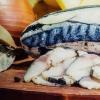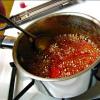Rotten fish in a jar is a delicacy. Disgusting food in the world: Swedish rotten herring "surstremming"
With this post, we decided to open a new section in our blog. It will be dedicated to the sights of different countries. True, not ordinary, but gastronomic. Today we are going to talk about the controversial Swedish dish surstremming (Swedish - Surströmming).
This delicacy leaves no one indifferent. As much as some admire the taste of this unusual herring, so others fiercely hate its rotten "aroma".
When I was little, my mother told me that in some countries, spoiled, from our, Russian point of view, products can be considered delicacies. I didn't believe it. In my six years, this seemed like a complete nonsense. How can someone willingly eat rotten fish or meat with a smell? But the story sunk into the soul. And now, two decades after that conversation, I completely voluntarily tried Swedish herring with a smell - surstremming.
While collecting information before traveling to Sweden, I came across a note about surstremming - rotten herring. In fact, this is not a rotten fish, but sour or sour. But the word "rotten" is the most common epithet for this dish.
We were only able to find a surprise at the main city food market in Stockholm. And then in one single shop. We took half of the four huge cans they had. Naturally, we were going to try this dish already in Russia.
It only remained to transport this canned horror to our homeland. Having wrapped the jars in several bags and overlaid with things, we put them in a backpack, which we checked in as luggage. With a backpack and clothes in it, we then mentally said goodbye. We knew that, due to the pressure, the bank could explode on the plane. Therefore, they do not sell it in the duty shops of Stockholm Arlanda airport. Major airlines such as Air France and British Airways banned this delicacy on board in 2006. In general, almost a terrorist herring.
We were worried about things all the way to Moscow. But having received nothing unusual smelling luggage, we calmed down. We were lucky: the cans of herring were swollen, but did not explode. During transportation, things were thrown heavily and only a “pillow” made of clothes did not allow my tripod to break through an already “swollen” can.
And yesterday, having found a like-minded person in the person of our friend, food blogger Olga fiery-ph0enix, we went to a deserted place on the banks of the Pakhra to taste this Swedish delicacy.
Surstremming has been known in Sweden for a very long time. One of the many stories of its origin says that in the 16th century during the war, the salt reserves of the Swedes were so scarce that so little salt was added to the herring for pickling that the fish fermented. But war and famine forced them to eat the stinking fish. As a result, no one died of indigestion, and some even liked the sauerkraut. Among the poor, herring sourdough became very common, because it required less expensive salt at that time.
Sour fish turned out to be not only cheap, but also useful. After all, the substances contained in it can prevent scurvy. Recipes for fermenting fish can be found in the cooking of other countries, for example, Norway or Japan.
Remember the Russian catchphrase “professor of sour cabbage soup”? And in Sweden you can be an academician of sour herring. In this country, in 1999, to maintain the tradition of cooking and eating fermented herring, the “Surströmmings Akademien” was organized. And in the coastal village of Sheppsmaln (I'm not sure if I transcribed it correctly, it is written in Swedish like Skeppsmaln) there is a museum dedicated to this dish.
But back to our experience of using surstremming. Under cover of night, we settled down on the banks of the Pakhra. We put a table, chairs, cut the necessary additional ingredients: onions, potatoes, dill, tomatoes.
Olga insisted that Keith open the jar with medical gloves on. He himself additionally covered the jar with a bag.
The precautions were taken for a reason. The very first hole left by the can opener on the lid and the jar “spat out” a trickle of marinade. Where is the smell? The package was ajar and a strong and acrid "aroma" of rotten eggs floated over the river. Keith walked away from the table, drained the marinade from the jar and rinsed the herring with water.
Life immediately became easier. Yes, and soon we almost breathed in this hydrogen sulfide smell.
Then began a long cleaning of the herring from the skin. It worked out with difficulty.
Judging by the video of cutting the surstremming, it was necessary to remove the entrails and scrape the pulp from the skin. As a result, one fish produced quite a bit of pulp and a couple of layers of caviar. Keith, like a man, decided to put himself in danger in order to save us. And put a piece of Swedish delicacy in my mouth.
It turned out to be salty, but quite acceptable. And then I started making sandwiches, as it was written on Swedish sites.
Swedish recipes describe that butter or crème fraîche (or a mixture of them) is spread on a “thin cheb” (which looks like something in between lavash and bread), finely chopped onion is placed, a few pieces of surstremming, herring is covered with pieces of boiled potatoes in uniform. Optionally add a slice of tomato and dill.
I didn't have butter and crème fraîche at home, so I replaced them with creamy soft cheese, the mention of which I also met, albeit rarely. I hope we haven't distorted the original taste too much. As for me, it turned out to be a good combination.
You can eat surstremming and not in the form of a sandwich, but simply with onions and boiled potatoes. By the way, they even make some kind of baked goods with surstremming. I’m scared to imagine how the kitchen and, especially, the oven will smell later.
According to our observations, sandwiches with a couple of fish are enough to eat.
And we liked the caviar more than the herring flesh. It's not that salty.
There is probably no need to eat surstramming just like that. It is very salty. And potatoes, butter and onions are a great addition to this dish.
Many people fear that the herring is “smelly” and, therefore, missing. Like, poisoning is guaranteed. Nothing like this. Surstremming only smells scary, otherwise everything is fine. He even has his guests.
The second myth is that pickled herring must be “disinfected” with schnapps, as the Swedes do, otherwise “three days of diarrhea and death”. We were not “disinfected” with alcohol, since most of our company was driving. And nothing terrible happened. But, yes, most often surstremming is washed down with schnapps and beer. It's just delicious. Wikipedia says that some connoisseurs generally wash down this herring with milk and praise it. We didn’t risk it.
Youtube is full of videos where people try Surprising and they feel sick. In fact, everything is not so scary, just eat sour herring like the Swedes do. Then you will get pleasure. May be. In any case, I liked the surprise. Not to shake, but the taste is good. True, it seems that in our company only I liked it. Apparently training with durian, a tropical stinky delicacy, makes itself felt. :)
By the way, we have one more jar of surstremming. So those who wish can join, have fun or test their willpower. There really is someone that. :)
An overview of the Swedish national dish - sauerkraut herring surstroemming and information on the topic. Materials from Swedish sources.
- audio file # 1

This image was recently posted on the Swedish blog lissej.
This image was recently posted on the Swedish blog lissej.blogg.se.
With the following caption: “A picture of this lady (tasting surstroemming herring) is included here to illustrate my hatred of pickled herring ...
This morning on the staircase we smelled a herring scent that was impossible to bear. Therefore, instead of slowly going down the stairs as usual, today I had to run along it.
You should prohibit eating pickled herring if you live in apartment buildings. "
At the beginning of the review, material from the program of the Russian broadcasting "Radio Sweden" from 11/05/2007 about pickled herring (herring is a type of herring) surströmming .. Audio fragment of the program from Stockholm is available in file in the upper left corner of this page.
Pickled Herring first freshness
“The listener asks for the name of the Swedish national dish - herring is not the first freshness. But this is a little bit wrong information. The herring is just the first freshness, it is called surstroemming. It's just that her salting is special, and what these features are said by Sergey Karlov (Russian broadcasting of Radio Sweden):
“This Swedish delicacy has already won the title of the most disgusting food in the world in prestigious international competitions. If you overcome your aversion to the smell that accompanies opening a can with this dish, you can feel its most delicate taste.
The Swedish people are divided into two camps - adorers and haters of this dish., for it is impossible to be indifferent to pickled herring, which is called with a smell. Smelly - this, of course, is putting it mildly.
This dish itself is an example of the ancient way of preserving fish that has survived to our time..
Once, half a thousand years ago, on one northern Swedish island in the Gulf of Bothnia, called Wolf, there was not enough salt to pickle fish. Salt was then very expensive, and, naturally, people tried to get by at a minimum - they were greedy. The fish in the tub fermented, but one brave man, apparently due to severe hunger, did not throw away the spoiled herring, but ate it. And yet he survived.
So, quite possibly, the Swedish tradition began, which cannot be found analogous to other peoples. Something similar, however, is in the northern countries: Norwegian sour trout, Greenland sour auk - such birds, the Icelandic method of fermenting shark meat. But only in Sweden, eating pickled herring has become a strong tradition, even a holiday. Of course, for those who love this activity. Most often, this year's herring is eaten, but few amateurs keep the jars for a year or two. This makes the taste and smell even stronger.
The Academy of pickled herring, or surstroemming, as this dish is called in Swedish, was organized. We will return to surstroemming in August, when the season for eating pickled herring comes ... "
(Russian broadcasting "Radio Sweden" from May 11, 2007 .. Audio fragment of the program from Stockholm is available in file in the upper left corner of this page).
About surstroemming
Herring is caught in April, before spawning... The head and entrails are removed, but the caviar is kept for the sake of taste. The appendix is also left as it contains enzymes essential for softening.
Herring is placed in barrels of caustic brine (saline) for several days to remove blood and fat... Then the fish is transferred to barrels with less concentrated brine, where it softens and sour for about two more months.
In July, it is closed in jars and placed in a cold place. For a long time, a royal decree was in force in Sweden, according to which the first surstroemming of the year could not be put on counters until the third Thursday of August.
In 1998, the decree was canceled, and now surstroemming can be traded all year round. However, at the request of the public, for surstroemming lovers, the third Thursday in August is still one of the biggest holidays of the year.
Monitoring site
Peculiarities
Swedish pickled herring
« Surströmming is made from small Baltic herring... It is caught in the spring and then fermented in sugar-salt brine, according to old recipes.
About a month before tasting, the herring is rolled into tin cans, but the fermentation process continues there, so over time the can acquires a somewhat rounded shape. Traditionally, the producers of this delicacy are concentrated on the northern coast of Sweden in the Norrland province.
Since in the jar, during the ripening of herring, the internal pressure significantly increases, it is supposed to open it under water, and rinse the fish before serving. The jar should be opened in the open air, and the contents should be served at the table at home, since the peculiar smell of pickled herring attracts flies.
Surströmming has a very sharp intense "smell"... True enthusiasts love the smell, while beginners sniff suspiciously. However, the taste of this dish is in no way adequate to its smell. According to all the rules, cooked herring has a delicate spicy and salty taste and requires certain gastronomic additives.
A traditional dish of pickled herring is a kind of sandwich.
On thin bread - soft or dried - a layer of butter is spread, and fillets of herring are placed on top, arranged with circles of almond-shaped potatoes and finely chopped onions.
Then all this is rolled up and eaten by hand. The slightly sweet taste of potatoes and onions ideally balances the intense taste of herring. In the province of Norrland bread, instead of butter, they prefer to smear with soft cheese made from goat's milk whey (getmessmör).
The season's premiere of pickled herring begins at the end of August, when the spring catch goes on sale. However, true connoisseurs prefer last year's catch. By this time, the fish has time to acquire its unique, "mature" taste
(From the information of the Swedish state agency for the dissemination of knowledge about Sweden "Swedish Institute").
Baltic herring, as well as her friend - eel
Here is an illustration from the archive: The Gulf of Bothnia in the Swedish province of Ongermanland, or the so-called. High coast.
Festive traditions of Sweden ”comments on a similar photo of these places:“ Here the mountain slopes approach the Gulf of Bothnia itself.
This is one of the main places in the Kingdom, where the "sweet herring" is now harvested.
The herring “smelly” now comes mainly from the province of Ongermanland, from the High Coast, where the mountain slopes approach the Gulf of Bothnia itself.
At the end of August and the beginning of September, two holidays are celebrated based on two different, specifically Swedish dishes, and they are celebrated at different geographical latitudes.
If crayfish (... Approx. site) is eaten everywhere here, the “tasting” pickled herring is a typical dish for northern Sweden, as well as a feast with eel is for southern Sweden.
Pickled herring is an example of an ancient way of preserving fish that has survived to this day.
Salt was then expensive, so unlike the salting typical for the North Sea regions, salt was used here just enough so that the herring would not spoil, but only fermented. This extended its shelf life.
Currently, Baltic herring is packaged in cans, where the fermentation process continues, so that after a year the cans swell and become almost round.
On one of the August days, the tasting of the last salting is solemnly celebrated and the lids of the cans are opened, which is accompanied by a rather burdensome smell, which is specific and for the inexperienced sense of smell.
Fig. from the archive: Surstroemming pickled herring and accompanying food.
The mentioned edition of the "Swedish Institute" "Maypole, crayfish and Lucia. Festive traditions in Sweden ”writes on how this dish is served and eaten:
"Onions and potatoes," marshy "bread and butter and, of course, various drinks - from milk to vodka - depending on traditions, habits and tastes are served with sauerkraut herring."
An unusually tasty northern variety of potatoes, distinguished by their almond shape and yellowish color, is served with herring.
All this is washed down with beer and vodka (although true connoisseurs prefer milk in this case) or wrapped in thin layers of unleavened bread made from barley flour, traditional for northern Sweden.
The production of pickled herring is concentrated on several islands in the Gulf of Bothnia and is a good example of how a product that was originally the food of the poor and helped to survive in harsh natural conditions has become a delicacy around which a kind of ritual has developed.
The autumn season, when the moon is at a loss and the nights are getting darker, is called "eel darkness" in southern Sweden, because at this time, the eel, heading to the Sargasso Sea, easily falls into fishing nets. Then the season of festive feasts opens, during which only one eel is served, but cooked, maybe, in 10-12 different ways: fried, boiled, smoked or grilled, as well as stuffed with different fillings.
If pickled herring is a shock to the sense of smell, then oily eel is a shock to digestion, the stimulation of which is favored by one or the other glass of alcohol. In restaurants, the culmination of the evening is often the election of the "king of the eels." This honorary title is awarded to the one who manages to catch the largest number of live eels from the barrel with his hands. "
(From the book of the Swedish state institution for the dissemination of knowledge about Sweden "Swedish Institute" "Maypole, crayfish and Lucia. Festive traditions of Sweden", English, Russian and a number of other languages, Stockholm. 1997 by Jan-Eyvind Swann) ...
Additionally:
Baltic herring is a national fish in Estonia
From the American newspaper "The Wall Street Journal" (June 2007):
“After emotional controversy, internet polls, allegations of fraud and parliamentary debate, Estonia, which is half the size of Maine, declared the little oily fish a national symbol a few months ago.
“Food has a political dimension,” explains Ruve Schank, an employee of the Estonian Ministry of Agriculture, recalling how in Soviet times the recipes and their names had to be approved in Moscow. - For me the proclamation of Baltic herring as a national fish is of great importance».
However, the choice of herring raises a number of questions. For starters, not many Estonians eat this fish. The Baltic Sea is one of the most polluted in the world, due to which the herring catch has declined in recent years. It happens that the herring contains a large number of dioxins, often exceeding the level allowed by the European Union, which Estonia joined in 2004. The Estonian fishing fleet has decreased almost threefold in ten years.
Moreover, of the 40,000 tonnes of herring caught last year, most of it was exported. Baltic herring prices - in local shops - around $ 1.6 a pound - are today largely determined by the international market, which makes fish expensive for many Estonians.
Some believe that pike would be a more worthy choice ... But the jury rejected pike on the grounds that Baltic herring, being a traditional dish in the Estonian diet, played a more important role in the life of the people throughout its history.
“It was the right choice,” says Valdur Noormagi, head of the Estonian Fish Union, the organization behind the idea of choosing the national fish.
“According to scientists, the Baltic herring has lived off our coast for 5,000 years,” notes Noormägi.
The declaration of Baltic herring as the national fish is part of a broader government campaign under the slogan “Fish does good”, urging Estonians to improve their diet by including more fish. A few weeks ago, the government launched an advertising campaign with posters showing a girl in a bikini with a fish in her teeth emerging from the sea, showing how fish can improve complexion.
Also, the government wants to promote. But first I had to understand what she was.
For years, the 1.4 million people, mainly engaged in agriculture, have been content with pork, sauerkraut, blood sausage and fried potatoes - a menu heavily influenced by neighboring Germany and Russia.
During the Soviet era, the authorities banned Estonian recipes as nationalist. In the 1955 Estonian cookbook, approved in Moscow, only 18 pages are devoted to Estonian cuisine - at the very end of the volume of 416 pages.
As a result, many Estonian recipes - for example, the popular festive dish rosolier, consisting of beets, potato salad and herring - fell out of favor during the Cold War and survived primarily among Estonian emigrants. After gaining independence in 1991, Estonians pounced on imported products such as German yogurt and American ice cream.
“Our food was practically lost,” says Karin Annus Karner, head of an Estonian school in New York and who recently wrote an Estonian cookbook. Estonian-American Toomas Sorra, a Brooklyn-based gastroenterologist who has frequently visited Estonia in recent years, says he only tasted herring once - at lunch at the Estonian consulate in New York. He notes that his relatives in Estonia love to fish for eels.
Now the government has decided to develop its own cuisine, in which the leading place is given to herring. Recently in the Estonian parliament a draft of the fish monument was discussed. Prominent figures expressed their opinion.
Dmitry Demyanov, a well-known Estonian chef and founder of the culinary institute in Tallinn, has appeared on television more than once and talked about the peculiarities of herring. The herring that is eaten in other countries, such as Finland, Sweden and Holland, is larger and "tougher" than its Estonian variety. “No one else has such a fish,” he says. "Ours is smaller and more tender."
Symbols such as the national fish are especially important for countries like Estonia, which previously enjoyed independence only 22 years before World War II, Demyanov said. “It shows the world that we are an independent country,” he says.
The Baltic herring has become a national symbol of Estonia, along with the cornflower and the swallow, chosen during the Cold War as a modest expression of national identity in the face of Soviet hegemony.
However, some argue that the government's time and money can be put to better use. The campaign to promote the fish, including advertising and brochure costs, cost more than $ 600,000. Some of these funds were received from the EU.
“I love Estonian food, but I don’t have to spend money on this nonsense,” says Leopold Garder, head of a transport company based in Tallinn. “We have a national flag, a song and a flower - that's enough.”
A disgruntled local newspaper editor quipped in an editorial that the national fish is the former agriculture minister who had the idea for the campaign, ”The Wall Street Journal pointed out.
This review has been prepared by the site on the basis of the following materials: programs of the Russian broadcasting "Radio Sweden" from 11/05/2007 about herring surstroemming; books by the Swedish government agency for the dissemination of knowledge about Sweden "Swedish Institute" "Maypole, crayfish and Lucia. Festive traditions of Sweden ", eng, rus. and a number of other languages, Stockholm. 1997 by Jan-Eyvind Swan; information from the Swedish public institution for the dissemination of knowledge about Sweden "Swedish Institute"; and also from the American newspaper "The Wall Street Journal" (June 2007);
What is not eaten in different countries: insects, offal, rotten meat. In Sweden, such delicacies include the well-known pickled herring (surstroemming). Not everyone eats it, but from year to year it becomes more and more popular. Pickled herring is a traditional Swedish dish, however, this fact of mass addiction to it does not explain itself. Believe it or not, those who eat surstroemming really love the taste of this fish. Otherwise, it is impossible to swallow it.
Surströmming is made from small Baltic herring. It is caught in spring, salted and fermented according to the classic recipe. About a month before it hits the store shelf, the herring is packed in airtight cans. At the same time, the fermentation process continues, and over time, the cans swell. By tradition, most manufacturers' factories are located along the northern coast of Sweden.
Surstroemming cannot be treated like regular canned fish. If the pressure in the can has increased and it is swollen, it must be opened under water. Then, before serving, the fish must be rinsed under running water. It is recommended to open the jar on the street, but it is better to eat its contents in the house - otherwise flies will immediately fly off.
Surstroemming has a strong and pungent smell of rotting fish. Fans of the delicacy like it, and those who are present at the opening of a can for the first time usually shy away in horror. But the taste of well-cooked pickled herring differs significantly from the smell, and in the positive direction: it is simultaneously rich and delicate, spicy and salty.
To taste the surstroemming properly, you will need a few more products. Traditionally, fillets are placed on thin bread, which is pre-spread with butter. There are also pieces of almond potatoes and chopped onions. All this is rolled up (klämma) and eaten with both hands. The sweet taste of potatoes and onions ideally neutralizes the harsh, rich taste of fish. In the north, bread is spread not only with butter, but also with soft goat cheese (getmessmör).
The season of surstroemming opens at the end of August, when the spring catch goes on sale. True connoisseurs, however, prefer last year's catch. During this time, the herring becomes tender and matures in taste.
Where does the smell come from?
Pickled Baltic herring is prepared according to the old method that was used in Northern Europe and Asia for storing fish. In the old days, this dish was the daily food of farmers in northern Sweden, and hunters often took it with them on long journeys. Today it is more of a traditional food. Eating a foul-smelling delicacy is a real test of courage that divides people into two camps: true fans of surstroemming and its ardent opponents.
Updated: 28/11/2018
Poo Tidholm and Agneta Lilja
Pu Tidholm is a Swedish journalist, writer and critic, regular contributor to the daily newspapers Dagens Nyheter and Aftonbladet, Filter and Fokus magazines, Swedish Radio and Swedish Television. Agneta Lilja is Senior Lecturer at the Institute for Historical and Contemporary Studies at the University of Söderturn in Stockholm.
Many nations create unusual, unique culinary masterpieces. Sometimes dishes made from insects and rotten meat are used. There are tons of fish delicacies. Perhaps someone has already tasted a Swedish delicacy - surstremming - this is canned pickled fish (more often herring). Not all people eat this delicacy, but this does not prevent it from remaining very popular.
What is pickled fish
Some people may be interested in what surprising is, how to cook this dish. The delicacy is often made from small Baltic herring caught in the spring. In ancient times, people dug round pits. The bottom and walls of the depression were covered with larch bark. Fresh fish was placed in the cauldron. The product was boiled but remained slightly moist. Then the broth was poured out of the boiler. The herring was dried, buried in a hole, covered with larch bark.
If we talk about modern specialized factories, then they use sealed cans for rolling herring. Some precautions are recommended when opening containers. It often happens that the pressure inside the cans increases greatly, which causes the canned food to swell. In this case, it is recommended to open them under water. Rinse the contents of the jar thoroughly before serving.
Often, pickled herring is placed on bread and butter (to make it tasty, the food is diversified with cheese made from goat's milk). Additionally, potatoes, onions, tomatoes, herbs, lingonberries can be used. The specified products are rolled. It must be consumed with both hands. Remember that surstremming has a pungent smell. It is successfully neutralized by potatoes. If we talk about drinks, then it is delicious to use beer, schnapps, kvass, milk with a delicacy. In a Swedish dish, carrots and onions can be found.
How to cook pickled fish
Any fish is used to create a delicacy. It is salted, after a few weeks canned (a detailed description of the preparation, you can find a photo on the network). If you want to get a truly exquisite dish, then to create a delicacy, you should use carp, podusta. It is also possible to produce a starter culture from the Greenland shark. This fresh fish is completely unsuitable for consumption, however, after special processing, harmful substances come out of it. Rotten fish can be eaten without fear.
Pickled fish recipes
There are many national recipes for creating a delicacy (you can find photos of popular dishes on the Internet). For example, in Vietnam, an analogue of surstromming is prepared from small fish that have not been gutted. It is salted (vats are used for cooking), placed in the sun. After some time, the fermented liquid is decanted. Typically, fresh fish is cooked for 4 to 12 months. Buryats create pickled herring in 1 day. By the evening, sour fish takes on the desired aroma. If we talk about common recipes, they are listed below.
Surstremming
- Cooking time: 2 months.
- Purpose: lunch, dinner.
- Cuisine: European.
Swedish herring with the smell of surstremming (photos with the design of the dish can be found on special resources) is prepared according to the traditional method. The same recipe for cooking can be offered by Norway, for example. It has been used by many peoples for several centuries (from about the 17th century). If the dish is prepared according to the established rules, then it will have a rich, delicate, pleasant aroma. Your loved ones will receive incomparable pleasure from the use of such a product.
Ingredients:
- Baltic herring, herring or other fish - 1 kg;
- salt - about 200 g;
- water - 2 l.
Cooking method:
- Peel the herring, cover it with caustic brine (salt solution).
- The herring will soften, turn sour in two months. Further, the product is preserved.

Pechora salted fish
- Cooking time: several months (time depends on the type of fish).
- Servings Per Container: 5-8 Persons.
- Calorie content: 102-168 kcal 100 g.
- Purpose: lunch, dinner.
- Cuisine: Siberian.
- Complexity of preparation: easy.
If you are interested in how to cook a delicacy in a weak brine, then read the indicated recipe. The product is not canned, but simply soaked in water with a small amount of salt. As a result, the main ingredient acquires its characteristic odor. To check its readiness, they take it by the tail, then pull out the spinal column with a quick movement. In this case, the bones should easily separate from the meat. If there is flesh on the spine, then the fish is not yet ready.
Ingredients:
- river fish - 1 kg;
- salt - 2-3 tbsp. l .;
- water - 2 l.
Cooking method:
- Peel the fish, place it in salted cold water.
- Leave the container for a few weeks (determine readiness according to the recommendations above).

Pickled herring
- Cooking time: 2-3 days.
- Servings Per Container: 5-8 Persons.
- Calorie content: 102-168 kcal / 100 g.
- Purpose: lunch, dinner.
- Cuisine: European.
- Complexity of preparation: easy.
Planning an unforgettable weekend? Someone may be interested in how to cook pickled herring, while spending little time. There is a dish that takes only 1 day to create. When using the described recipe, you will get a sour-salty product with a specific aroma. The delicacy is delicious to eat with bread, vegetable garnish, beer, kvass.
Ingredients:
- river, sea fish - 1 kg;
- salt - about 100 g;
- water - 50 ml.
- carrots - 2 kg;
- onions - 2 kg;
- vinegar - 100 g;
- vegetable oil to taste.
Cooking method:
- Peel the fish, rub thoroughly with salt, put in a container, close the lid, put in a cool place.
- After 2-3 days, the herring is washed in water and dried. Then it is cut into pieces.
- The product is fermented.
- Sprinkle raw onions and carrots on top of the dish. Add vinegar, vegetable oil, sprinkle with water.
- After 2-3 hours, the fish will acquire the desired aroma, pleasant taste.
Video
The Swedes assure that what smells disgusting is actually very tasty. "Gentle" and "delicate", those who tried it say about it. Summer is the season of surstroemming, and we decided to tell you why you shouldn't be so afraid of this delicacy.
Surstroemming is one of the ten most unpleasant dishes in the world. However, this product with a difficult to pronounce name is nothing more than a simple fermented herring. Or rather, Baltic herring. Sur here - "sour", "pickled", strömming - "Baltic herring".
Whom to believe? Gourmets who recommend trying this delicacy at all costs and awakening new taste buds, or a sense of self-preservation? It will definitely remind of itself to those who inhale the contents of the jar for the first time. The acrid, pronounced smell of a rotten, long-rotten product, as it were, warns: do you really want to eat this?
Remember the famous Asian fruit durian? Surströmming could well be called "Swedish durian". When you try to eat it ... tears come to your eyes, a lump rolls up to your throat. As if suddenly an attack of seasickness began, and you are a passenger on a ship whose captain went to fish for Baltic herring in a severe storm. And these are not weaknesses nervous system visiting tourist. For the sake of fairness, it should be noted that in Sweden itself, not every inhabitant is a fan of the product. Therefore, sitting at a large buffet, you can often meet those who avoid canned food. This is mainly the younger generation.
Why do they eat it?
Surströmming was "invented" in the 16th century, during the Swedish-German war, when the country was hit by a food crisis. Salt became scarce, and the amount in canned food had to be reduced. The soldiers were the first to taste the fermented fish, followed by the peasants and the entire nation. Many generations have become accustomed to specific food. And now, when pickled herring is no longer needed for survival, there is one - either a tribute to tradition, or a conscious choice.
Until 1998, by order of the king, banks could not be opened until the third Thursday of August. That is, no one ate the product every day. But on the day of surstroemming (every third Thursday in August), you can find it in almost every home. True connoisseurs prefer to feast on last year's catch with a more mature taste.
The secret of making
Small fish are caught in April. In the factory, internal organs and heads are removed from it, sometimes leaving eggs. To get rid of fat and blood, the product is placed in barrels of highly concentrated brine. This process takes several days. The fish spends the next couple of months in a slightly salted solution. She becomes very tender and soft. The final rolling of the surstroemming into the cans takes place in the summer. In the process of further fermentation, the fish acquires a smell that made it famous all over the world. Its secret is in substances that form fish enzymes and bacteria: hydrogen sulfide, butyric, acetic and propionic acid. By the way, if you see canned food with "rounded" shapes on the shelves, they are not swollen. These are just traces of high pressure inside the can.
Interesting facts about surstroemming
These foods can help you make friends with unconscious canned herring: boiled potatoes, bread or tortillas, vegetables, butter, and cheese. Many people like to wash down a fish sandwich with schnapps. In extreme cases - beer or kvass. Well, for an amateur - milk. When eating this delicacy, follow Buddhism - listen carefully to yourself and your feelings.
Banks must not be opened in the air. The canned food should be placed in a container of water and carefully punctured there (somewhere in the backyard). This will help soften odor, equalize pressure and avoid splashing. After all, the fish continues to ferment, even if the bank is closed.
A similar recipe for salting fish is also used in the Komi Republic. There it is called "Pechora salting", and such a dish is eaten with spoons.
The price of the product is much higher than you expect from a can of canned food. This is because surstroemming requires special transportation conditions. For the same reason, in other countries, it falls into the category of elite.
The production history goes back over 500 years. Most of the Swedish herring lovers live in the north-east of Sweden. A museum dedicated to canned food is located in Shepsmalm.
Like durian, this product is banned from carriage by many airlines.
And finally
As subtle connoisseurs of flavoring shades say, the sharp, repulsive smell of surstroemming only better emphasizes its pleasant (pungent and rich) taste, contrasting with it. "Delicate" and "delicate" are not characteristics of a loved one, but epithets that fans award the product with. The real taste of canned food is not rancid, but spicy and sour, they assure.
Swedish herring is a delicacy that will definitely not leave you indifferent. Either you will like it, or absolutely not. All prejudices aside, you may be able to penetrate them. You definitely won't get poisoned. But the aftertaste - not even in the mouth, but in the stomach - can stay with you for several days. If you get used to surstroemming, then gradually. You probably won't be able to put several large pieces on bread at once and eat them at once. But if this suddenly happened, there is something to think about: perhaps there were real Vikings among your ancestors?


















